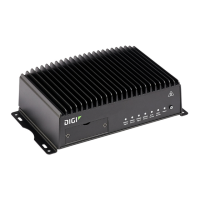Wide Area Networks (WANs) WAN failover
Digi TransPort WR Routers User Guide
58
Active vs. passive failure detection
There are two ways to detect WAN failure: active detection and passive detection.
n Active detection involves sending out IP probe packets (ICMPecho requests) to a particular
host and waiting for a response. The WAN is considered to be down if there are no responses
for a configured amount of time. See Using IP probing to detect WAN failures.
n Passive detection involves detecting the WAN going down by monitoring its link status by some
means other than sending IPprobe packets. For example, if an Ethernet cable is disconnected
or the state of a cellular interface changes from on to off, the WAN is down.
Using IP probing to detect WAN failures
Problems can occur beyond the immediate WAN connection that prevent some IP traffic from
reaching its destination. Normally this kind of problem does not cause the WAN to fail, as the
connection continues to work while the core problem exists somewhere else in the network.
You can use IP probing to detect problems in an IP network. IPprobing involves configuring the
TransPort device to send out regular IP probe packets (ICMP echo requests) to a particular
destination. If there are no responses to the probe packets, the TransPort device can bring down the
WAN and switch to using another WAN until the problem is resolved.
IP probing includes the following options:
n probe-host: The IPv4 or fully qualified domain name (FQDN) of the address of the device itself.
The WAN failover feature sends probe packets over the WAN to the IPaddress of this device.
n probe-interval: The interval, in seconds, between sending probe packets. This value must be
more than the probe-timeout value.
n probe-size: The size of probe packets sent to detect WAN failures.
n probe-timeout: The time, in seconds, to wait for a response to a probe. This value must be less
than the probe-interval and timeout values.
n activate-after: The time, in seconds, that the primary interface needs to be up before
switching back to it as the active interface. If probing is active, no probes are permitted to be
lost during this period. Otherwise, the timer is restarted.
n retry-after: The time, in seconds, to wait before retrying this interface after failover. Use a
large retry timeout when both interfaces are cellular interfaces.
n timeout: The time, in seconds, to wait for this interface to connect before failing over to a
lower priority WAN. Note that once the device has successfully connected and then the
connection is lost, it will immediately fail over to the next WAN, regardless of the Timeout
parameter.
Example: WAN failover from Ethernet to cellular
In this example WAN, the eth1 interface associated with wan1 serves as the primary WAN, while
cellular1-sim1 and cellular1-sim2 are associated with wan2 and wan3, respectively, and serve as
backups.
Note The WR64 and some variants of the WR54 have a second modem with two additional sim slots.
On these devices, up to four cellular interfaces can be associated with WANs.

